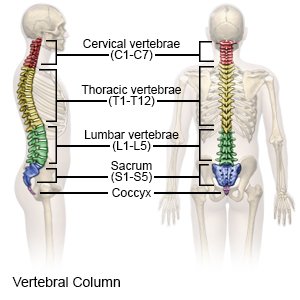Intrathecal Analgesia
Medically reviewed by Drugs.com. Last updated on Apr 6, 2025.
What is intrathecal analgesia (IA)?
IA is a type of pain control. It is also called spinal anesthesia. Pain medicine is injected around your spinal cord to control pain from surgery or labor and delivery. IA can also be used to control long-term pain from illnesses, such as cancer.
 |
How will happen during an IA injection?
Your healthcare provider may give you a single injection of IA if you need pain relief for a short period of time. He or she will use a needle and insert medicine into the area around your spine. He or she may insert a catheter (tube) that will remain in place if you need pain controlled over a longer period of time. This will allow you to have pain relief as you need it.
Drugs used to treat this and similar conditions
Hydrocodone
Hydrocodone (Hysingla ER and Zohydro ER) is used for around-the-clock treatment of severe pain ...
Cymbalta
Cymbalta (duloxetine) is used to treat major depressive disorder, general anxiety disorder and ...
Ozempic
Learn about Ozempic (semaglutide) for type 2 diabetes treatment, weight management, cardiovascular ...
Oxycodone
Oxycodone is an opioid analgesic used to treat moderate to severe pain; it has a high potential for ...
Tylenol
Tylenol is a pain reliever and a fever reducer used to treat many conditions such as headaches ...
Acetaminophen
Acetaminophen is a widely used pain reliever and fever reducer for conditions like headaches ...
Ibuprofen
Ibuprofen (Advil, Motrin) treats minor aches and pains caused by the common cold, headaches ...
Gabapentin
Gabapentin is an anti-epileptic drug, also called an anticonvulsant. It is used to treat some types ...
Acetaminophen/hydrocodone
The combination of hydrocodone and acetaminophen is used to relieve moderate to severe pain ...
What should I expect after an IA injection?
A headache is common after IA. The following can help you manage the pain:
- Rest as needed. Lie down until your headache is better.
- Drink more liquids. You may need to drink more liquids for the first 12 to 24 hours following your procedure. This may help decrease your risk for a headache. Liquids containing caffeine may also decrease the pain. Do not drink alcohol. Ask your healthcare provider how much liquid to drink each day and which liquids are best for you.
- Medicines:
- Acetaminophen decreases pain and fever. It is available without a doctor's order. Ask how much to take and how often to take it. Follow directions. Read the labels of all other medicines you are using to see if they also contain acetaminophen, or ask your doctor or pharmacist. Acetaminophen can cause liver damage if not taken correctly.
- NSAIDs , such as ibuprofen, help decrease swelling, pain, and fever. NSAIDs can cause stomach bleeding or kidney problems in certain people. If you take blood thinner medicine, always ask your healthcare provider if NSAIDs are safe for you. Always read the medicine label and follow directions.
What are the risks of spinal anesthesia?
Your blood pressure or breathing may become too slow. You may have nausea or itching skin. You might have trouble urinating. You could have bleeding, swelling, or a leakage of spinal fluid around the catheter or shot area. Rarely, you could get an infection in your head or spine.
Care Agreement
You have the right to help plan your care. Learn about your health condition and how it may be treated. Discuss treatment options with your healthcare providers to decide what care you want to receive. You always have the right to refuse treatment. The above information is an educational aid only. It is not intended as medical advice for individual conditions or treatments. Talk to your doctor, nurse or pharmacist before following any medical regimen to see if it is safe and effective for you.© Copyright Merative 2025 Information is for End User's use only and may not be sold, redistributed or otherwise used for commercial purposes.
Learn more about Intrathecal Analgesia
Care guides
Further information
Always consult your healthcare provider to ensure the information displayed on this page applies to your personal circumstances.
